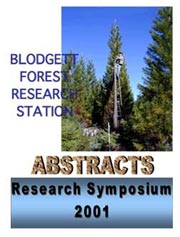Tree leaf area has been used to express three-dimensional growing space and to determine growth efficiency of individual trees in uneven-aged stands. In complex stand structures of multi-aged mixed-conifer forests growth efficiency varies remarkably with canopy position and species. In our study of stand dynamics of Sierra Nevada mixed-conifer forests, we are developing tools to describe structure and growth of multiaged forests on a physiological basis. Six species in various canopy positions were sampled to develop leaf area - sapwood area relationships. With the use of these relationships it is possible to determine leaf area on a per tree basis from increment cores. We collected site and tree specific data of vapor pressure deficit and water potential to isolate factors influencing the leaf area – sapwood area ratio. Knowledge of these variables will help us to apply the LA/SA ratio over a range of sites with different environmental conditions.
In light limited environments, tree growth efficiency is influenced by the amount of light the tree crown receives, which depends on the position of the crown within the canopy and the spatial arrangement of trees. We hope to isolate this relationship by modeling the amount of light, which a particular crown receives, using a spatially explicit light transition model. In order to calibrate the model to this particular forest type, we took hemispherical photographs in a two-cohort stand and determined gap light index in collaboration with Dr. John Battles. 60 hemispherical photographs were taken at two different heights using a nested plot design. Understory light intensity (gap light index) will be compared with values calculated with the light model.
Overstory and understory trees on 1 ha of this two-cohort stand were mapped. We took allometric measurements of tree crowns and increment cores of stems at breast height. This stand represents the first in a sequence of stands with multiple cohorts where we will determine tree growth efficiency, expressed as stem volume increment per unit leaf area, and local light environment. This stand sequence will enable us to model the growth of trees in various canopy positions and spatial arrangements, and to develop stocking guidelines for multi-aged mixed-conifer stands.
 |
Photo by Bob Heald
|
TIMBER HARVESTING:
A mainstay of the Georgetown Divide since the 1850s, logging was introduced to Blodgett Forest in 1956. Timber harvesting began to be used as a major silvicultural management tool in 1976. Harvest activities are scheduled between June and October of each year, starting when the ground is no longer completely saturated, to prevent soil compaction, and ending when the rainy season is expected and the ground will be moist.
Environmental impact is kept to a minimum. Snags are left standing for wildlife recruitment, litter and duff are left in place to decrease erosion. Roads are repaired, replaced or abandoned, as needed, and water bars or direct erosion controls are put into place wherever required to protect watershed.
The average age of a tree cut during a Blodgett Forest harvest is 89-90 years in group cuts, and 30-40 years in a single tree selection harvest. A typical 80 year old Ponderosa Pine tree will be approximately 130 feet high, two to three feet in diameter, and contain an average of 1,000 thousand board feet.
Harvesting at Blodgett is nearly all done by "tractor" methods, ground skidding. The type of harvest is determined by access and slope.
|
|
 |
Photo by Frieder Schurr |
 |
Photo by Bob Heald |
|
Contact Author: Rolf Gersonde, Department of Environmental Science, Policy & Management, 239 Mulford Hall, University of California, Berkeley, Berkeley, CA 94720-3114, (510) 643-2025, e-mail: gersonde@nature.berkeley.edu
|




